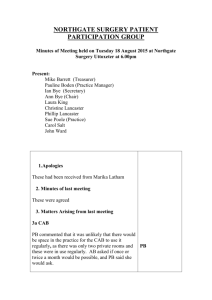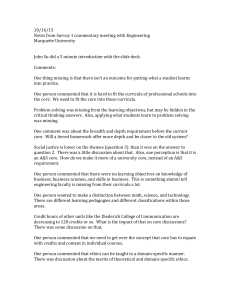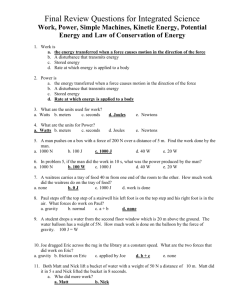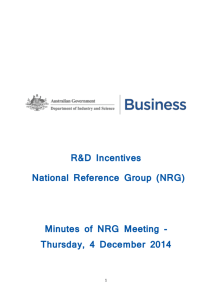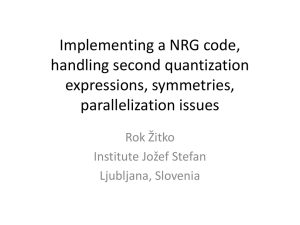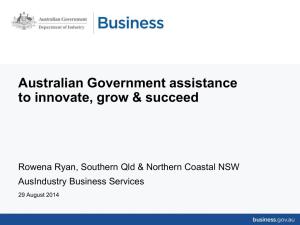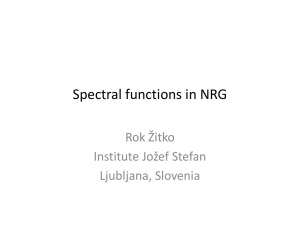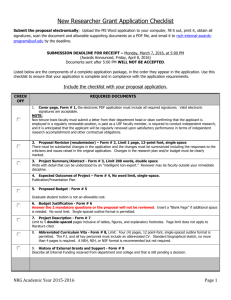11 June 2015 Minutes (DOCX 108KB)
advertisement
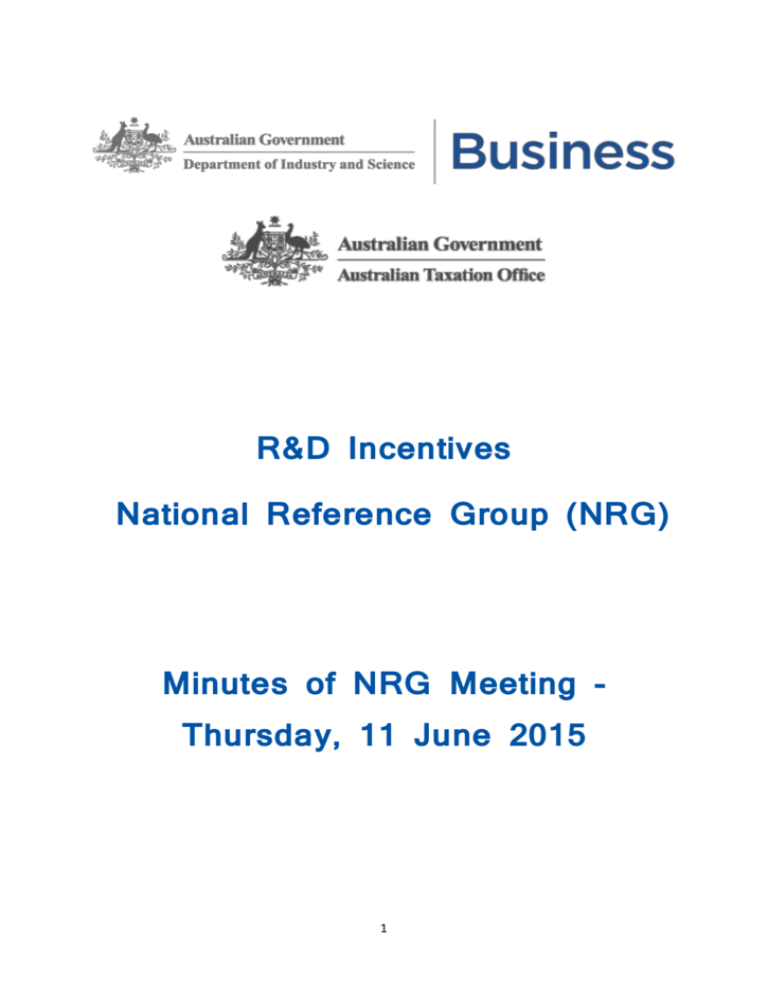
R&D Incentives National Reference Group (NRG) Minutes of NRG Meeting Thursday, 11 June 2015 1 Attendance & Apologies 1. NRG Members: NRG Co-Chair Malcolm Allen - ATO NRG Co-Chair David Wilson - AusIndustry Donna Bagnall - Chartered Accountants Australia & New Zealand Sandra Boswell - Pricewaterhouse Coopers Leigh Conlan - CPA Australia Jason Dunnachie - Deloitte (proxy for Serg Duchini) David Fox - Corporate Tax Association Margaret Hartley - Academy of Technological Sciences & Engineering Paul McMullan - Compliance Group Jamie Munday - Ernst & Young Melanie Reen - Michael Johnson Associates (proxy for Kris Gale) Paul van Bergen - KPMG (proxy for David Gelb) Innovation Australia: Dr Marlene Kanga, Chair R&D Incentives Committee of Innovation Australia ATO: Jared Birbeck, Public Groups and International AusIndustry: NRG Secretariat Veronica Morales Chris Enders, Manager, R&D Tax Programme Management Andrew Lewis, Manager, R&D Tax Integrity Assurance Joachim Schoen, A/g Manager, R&D Tax Programme Management Adrian Wilson, R&D Tax Integrity Assurance (part-meeting attendance) Department of Industry & Science: Mark Johnson, Manager, Business R&D The Treasury: Kate Lynch, Small Business Tax (part-meeting attendance) Alex O’Keeffe, Small Business Tax (part-meeting attendance) Kurt Enchelmaier, Tax White Paper Taskforce (part-meeting attendance) Apologies: Serg Duchini – Deloitte Kris Gale – Michael Johnson Associates David Gelb - KPMG Rudi Werner - The Fourth Wave Minutes and actions arising from previous meeting 2. No issues were raised with the minutes of the meeting of 6 December 2014 which were circulated to NRG members on 19 February 2015 and subsequently posted to the AusIndustry website. Donna Bagnall noted that the name change of Institute of Chartered Accountants to Chartered Accountants Australia and New Zealand needs to be reflected. 2 Action Item 1 (The ATO will consult with NRG members as an alternative R&D Schedule calculator is scoped) o This action item is closed. Jared Birbeck noted that while there is currently no work being done on the R&D Schedule calculator, the ATO will continue to collect feedback from NRG Members, to be considered for future updates. Action Item 2 (A link to the 2012-13 Science Research and Innovation tables will be circulated to the NRG membership) o This item is closed. A link to the 2012-13 SRI tables was emailed to NRG Members on 29 January 2015. David Wilson commented that SRI tables report on Government expenditure on research and development over a 10 year period, including Budget estimates for the current financial year. Adjustments to the forward estimates in Budget Paper No.4 will be reflected in the SRI tables released around September. Action Item 3 (Publish the Specific Issue Guidance topic on Feedstock). o This item is closed. The Feedstock Specific Issue Guidance was released in the April 2015 R&D Tax Incentive Bulletin. Action Item 4 (Provide feedback on the Registration smart form to AusIndustry) and Action Item 5 (Provide feedback on the Advance/Overseas Finding smart form to AusIndustry) o These items are closed. David Wilson informed the meeting that AusIndustry is undertaking an IT capital project for the 2015-16 financial year to address a number of system and form matters. There will be further opportunities to provide feedback on the Registration and Advance/Overseas Finding forms through this process. Ongoing feedback from members is welcomed. Strategic Matters 3. 3.1 Programme Performance David Wilson presented an overview of key programme performance data on registrations for the 2012-13 and 2013-14 financial years (noting that the 2013-14 data is incomplete as registration for non-standard year balancers will continue until October). There has been an increase of approximately 10% in terms of registrations (including subsidiaries), with the increase noticeable in registrations with turnover of less than $20m. Joachim Schoen commented that the R&D expenditure figures presented are inclusive of feedstock. In 2012-13 feedstock accounted for $2.4bn. Although it is difficult to forecast the expenditure coming with late-balancers, feedstock will likely account for approximately the same amount of expenditure in the 2013-14 year. Malcolm Allen commented that the number of registrations exceed the number of tax return claims made. Jared Birbeck commented that approximately 5-10% may not lodge after registration. A comparison of the share of registrations by industry sector for the top six sectors for 2012-13 and the incomplete 2013-14 years shows an increase in the Service sector 3 (which includes professional, scientific and technical services; information media and communications services; and financial and insurance services). The comparison also shows a slight decrease in manufacturing and mining sectors. Paul McMullan commented that a further breakdown of the services sector would provide more meaningful insight as services are evident across various other sectors e.g. mining and manufacturing. David Wilson commented that the Innovation Australia annual report includes further breakdowns, and AusIndustry is undertaking deeper analysis of data at the sub-sector level. AusIndustry also collects data on research field via the registration form, and is doing some analysis by research field as opposed to industry sector. Leigh Conlan commented that a comparative analysis and identifying any trends will be useful to see where the growth in the programme is originating. David Fox commented that it would be interesting to see a breakdown of turnover by industry sector, what is occurring amongst the larger registrants, and the influence of the $100m threshold. David Wilson commented that AusIndustry has undertaken some analysis of sub-cohorts by turnover and registrants with under $500,000 turnover account for just over 30% of total registrations, and registrations for entities with less than $20m are around 74% (for the 2012-13 financial year). David Wilson presented a State breakdown, which shows no dramatic changes between the years. Action Item: The PowerPoint slides used for this session will be distributed to NRG Members. Action Item: David Wilson encouraged NRG Members to think about what specific analysis they would see as useful and to let AusIndustry know. AusIndustry will work with the Innovation Australia Board and R&D Incentives Committee to determine what data analysis can be made public. Margaret Hartley asked whether it was possible to identify how the programme interacts with other programmes, for example, the Growth Centres, and also with State & Territory-based programmes such as the voucher programmes in Victoria and NSW. This would provide a broader picture of innovation and research-industry connections, and may also reveal whether businesses progress through a sequential pathway for innovation growth i.e. does participating the R&D Tax Incentive flow on to, or assist with, accessing other programmes? Action Item: David Wilson noted that areas of the Department of Industry & Science may have data on State-based programmes and AusIndustry and the R&D policy area will investigate what is available. David Wilson presented a summary of Advance/Overseas Findings received as at 30 April 2015. Of the 702 received, there are 41 remaining to be finalised. AusIndustry has observed a more even spread of Advance/Overseas Finding applications throughout the year which has assisted AusIndustry to process applications. Sandra Boswell sought clarification between an ‘ineligible finding’ and a ‘refusal’. Andrew Lewis commented that the decisions Innovation Australia make include eligible (including partially eligible) or ineligible findings. If Innovation Australia is of the view that there is not enough information provided to determine whether an 4 activity is eligible or not eligible, it can refuse to make a finding. This is a reviewable decision, and often companies subsequently produce additional information in order for a finding to be made. David Wilson asked NRG Members whether they foresee many Advance/Overseas Finding applications to be submitted leading into the 30 June deadline. Paul van Bergen commented that the number will probably be less due to findings lasting three years. Andrew Lewis commented that joint AusIndustry-ATO guidance has been published confirming that Overseas Findings apply for the duration of the activity. Paul van Bergen commented that now that we are into the third year of Findings the process is smoother as everyone has a better understanding of what is required. Jamie Munday echoed this comment stating that the process has been a learning experience for everyone but now there is more clarity on what is required. David Wilson informed NRG Members that enhancements to the Finding form will be made to improve processing and assessment as part of the Programme’s IT Capital Project, and the NRG will be consulted. Marlene Kanga commented that from the Innovation Australia Board’s perspective, the online guidance provided is very important. This is an ongoing work stream of the Board to help to reduce burden on companies. Feedback from the NRG on areas for possible improvement to forms and online guidance was welcomed. 3.2 Programme Developments David Wilson provided an update on recent programme developments. In relation to the introduction of the $100m threshold legislation, AusIndustry sent draft guidance to the NRG in late May for consultation. Feedback was due by 10 June 2015. AusIndustry will look to finalise and publish the guidance in the coming weeks, by 30 June 2015. The rate reduction measure was reintroduced to the Lower House on 27 May 2015. As yet there is no indication as to when it will be debated. The legislation has been reintroduced as a T-Bill so it would be moved forward as a priority. Malcolm Allen noted that if passed, the law will be applied as is – that is, tax returns will need to be amended if the law is backdated. Mr Allen advised NRG members that they should keep their clients aware that they should expect an amendment to have to be made if the legislation is passed. The ATO’s standard policy on penalties and interest for these situations will be applied i.e.: ‘No tax shortfall penalties will be applied and any interest accrued will be remitted to the base interest rate up to the date of enactment of the law change. In addition, any interest in excess of the base rate accruing after the date of enactment will be remitted where taxpayers actively seek to amend assessments within a reasonable timeframe after enactment.’ Donna Bagnall asked whether the 10% clawback rate will be adjusted should the rate reduction pass. Jared Birbeck commented that there is no mention of changes to the clawback rate in the Bill. David Wilson informed NRG members that AusIndustry received around 1600 registration applications on 30 April, and all were processed within the service standards. Mr Wilson sought feedback from NRG members on their experience of the registration peak processing period. 5 o Leigh Conlan commented that the processing was better than the previous year in terms of turnaround timeframes. o Jamie Munday commented that AusIndustry was responsive and any issues that arose were resolved quickly, with direct contact being made with customers by AusIndustry in a timely manner. o Joachim Schoen commented that some earlier improvements to the form, and a better resourced registration team, took pressure off the registration systems to allow for a smooth peak period. Jamie Munday asked how the messaging that was recently released by the ATO in regard to fraud and compliance is being interpreted. Paul McMullan also asked if there are examples of the fraud/schemes being used. David Wilson clarified that the messaging released was in regard to the promotion of tax avoidance arrangements, and that these may attract the application of the Promoter Penalty Laws. Mr Wilson commented that the messaging is also a reminder to tax agents that they should be conducting appropriate due diligence if a third party R&D consultant has completed an R&D claim for their client. Malcolm Allen reinforced the message that if you are a registered tax agent completing a tax return for a tax payer, then you need to check any R&D documentation and figures received from a third party, and understand the bona fides of that third party R&D advisor. Mr Allen commented that enforcing the Promoter Penalty Laws includes a spectrum of outcomes from a voluntary cease agreement, through to imprisonment. Both Mr Allen and Mr Wilson commented that these messages are out there as reminders for tax agents, R&D advisors, and customers/tax payers. The ATO and Ausindustry continue to work closely to ensure the integrity of the programme. Operational Matters 4. 4.1 NRG Member Items Feedstock Specific Issue Guidance Melanie Reen raised two questions on the recently released Feedstock Specific Issue Guidance (SIG): ‘Can the guidance be relied upon by companies seeking to opt out of the feedstock adjustment calculations’ and ‘how narrowly should the excluded activities be defined?’ Andrew Lewis informed NRG members that companies can rely on the guidance. Jared Birbeck commented that ATO TR2013/3 provides an example that refers to choosing to not register activities and therefore there is now claim and therefore no feedstock adjustment. Jamie Munday referred to PS LA 2008/3 Provision of advice and guidance by the ATO and asked whether this guidance could be added to this list of material. Jared Birbeck responded that since the Feedstock SIG is a joint guidance product, and not strictly an ATO product, it will not be added to the list. If NRG members feel that 6 an ATOID is required on this subject, then they can request one from the ATO however the Feedstock SIG should provide the framework to choose not to register activities that would require feedstock adjustment. $100m Threshold Guidance Melanie Reen put forward the question: ‘Should companies expect to register projects totalling exactly $100m?’ Andrew Lewis reiterated that draft guidance sent to NRG for consultation describes how AusIndustry intends to administer the $100m threshold, but that companies would need to consider their own circumstances. Sandra Boswell commented that some companies may look to register more at the time of registration so that they do not have to undertake a variation in the future should compliance activities reveal some activities are ineligible. Ms Boswell commented that consideration needs to be given to how these deductions are treated as there may be timing benefits or issues if they are claimed under the R&D Tax Incentive rate or the 30% rate. Jared Birbeck commented that these are commercial decisions that need to be made i.e. on how much a company registers. The ATO position is that what a company registers is what the ATO will expect to be claimed. Sandra Boswell commented that the terminology “normal deduction” used in the draft guidance needs to be more clearly defined. Jared Birbeck commented that ‘normal’ refers to a normal versus notional deduction. Melanie Reen commented that if a company registers $100m, however in the future is required to make a variation due to some compliance activity, the company may not have been keeping the same standard of records. Ms Reen asked what AusIndustry’s expectations are on record-keeping in this case, and suggested that the guidance should include this. Andrew Lewis commented that AusIndustry expects an adequate standard of record-keeping with evidence to substantiate claims regardless of timing. The draft guidance makes mention of this. Sandra Boswell commented that the guidance should make clear that the company also has to be within the four-year timeframe for amendments to be made. Jared Birbeck commented that if a registration is amended, then the ATO would expect that the relevant claim would be amended to exclude expenditure related to R&D activities that were found ineligible by AusIndustry through compliance processes. Andrew Lewis reiterated that AusIndustry is aiming to release this guidance by the end of June 2015. Action Item: David Wilson commented that any further comments on the draft guidance should be sent to AusIndustry by close of business, Tuesday 16 June to allow for AusIndustry to finalise the guidance. 7 New Knowledge Paul McMullan raised a question around ‘new knowledge’ and the evidence required for ‘significant purpose’. If a scientific method is being followed, which needs a hypothesis to determine whether you can do something that is currently unknown, then undertaking an experiment to test the hypothesis will generate new knowledge (that either ‘yes, you can’ or ‘no, you can’t). Andrew Lewis did not disagree with this approach, however noted that the ‘new knowledge’ element is not the only element of the definition that needs to be satisfied and evidenced. Mr Lewis also commented that part of the reason for the ‘new knowledge’ purpose test is to look at what other purposes there are, in order to determine if it is a ‘significant’ purpose. An experiment can illuminate that a business is undertaking that experiment to generate new knowledge; however it also needs to consider the rest of the definition. Paul McMullan commented that he has found that if a hypothesis is structured well, the new knowledge easily flows on. Overseas & Advance Findings – Changes in Activities On Rudi Werner’s behalf, Paul McMullan introduced questions Mr Werner put forward in relation to changes in activities covered by Advance/Overseas Findings. Andrew Lewis responded that if there is a change in activities, the activities still need to be substantially the same as those covered by the Finding for the Finding to continue to apply. Findings are there to provide certainty to the company. If there is any uncertainty for the company, in that it itself is unsure whether it is carrying on the same activities, then the first step would be to contact AusIndustry to discuss whether the change in activities needs to proceed to applying for a new Finding. Mismatch of expenditure On Rudi Werner’s behalf, Paul McMullan introduced Mr Werner’s questions seeking clarification on how to handle circumstances where there is a mismatch of expenditure listed in registration documentation versus the tax return. Jared Birbeck responded that in 355-205 there is an example of where expenditure is incurred in the current year, but the activity is undertaken in the following year. In this case, you cannot register in the year of the expenditure because there was no activity in the same year. Therefore you would amend the return in the year of registration. The same process applies for the reverse (i.e. activity in one year, expenditure in another). Mr Birbeck reinforced that you can only register in the year that you do the activity, however you can use the registration number for future claim years. Within the ATO’s internal processing systems, these situations will be picked up as a point for questioning, however it should be relatively easy to explain why the activity year and claim year do not match. Registration for part-year members of consolidated groups Leigh Conlan put forward the question of registration process and dates for companies who are part-year members of consolidated groups. 8 Jared Birbeck commented that the ATO has guidance on substituted accounting periods. The length of an income year does not change, and the timeline for registration is ten months after the end of an income year. Joachim Schoen commented that if a change to the company details involves a change to the tax grouping it may have to register twice, each time for part of an income year. One registration would be lodged for the period of time for which the entity operated in its own right; the second registration will be for the period of time the entity was part of a consolidated group. David Wilson commented that if members thought there is a need for guidance to be supplemented to reflect this, it can be discussed out-of-session. 4.2 Administrative Update David Wilson presented a summary of compliance activities for 2014-15 as at 30 April 2015. The number of activity reviews rated as ‘high’ compliance risk is reflective of the more targeted risk assessment process undertaken by AusIndustry. Andrew Lewis informed NRG members on the Large Business Review (LBR) process. These reviews are focused on engaging with the largest companies, jointly with the ATO. The outcome of these reviews is that a compliance risk rating is applied in relation to R&D activities and systems, and then to work with companies to establish how compliance risks can be resolved, either through being voluntarily addressed by the company or through a Finding process if necessary. LBR pilots were conducted over the last 12-18 months, with 7 LBRs initiated in 2014-15 and the view to engage 6-8 companies in LBRs each year going forward. Sandra Boswell asked if there were any patterns or themes emerging in the LBRs. Mr Lewis responded that the sample is too small. Ms Boswell asked whether there were any trends or themes emerging in the broader group of compliance activity. Mr Lewis commented that yes, quality is improving although there is still a reliance on assertions that R&D is being undertaken without the appropriate evidence to demonstrate the eligibility of activities. Action Item: David Wilson informed members that AusIndustry is holding a Risk Workshop in June that includes staff from across the AusIndustry Network and the ATO, and will use it as an opportunity to develop a list of the ‘top 5’ issues/trends being seen from compliance activities. Paul van Bergen referred to the ATO 2013 compliance statement which included a focus on large business that indicated that large businesses had not yet adapted to the new definition. Mr van Bergen asked whether the ATO has seen any improvements in this space. Malcolm Allen responded that R&D is still within the risk focus of the ATO. Paul McMullan asked whether there were any ‘good news stories’ from the move from the R&D Tax Concession to the R&D Tax Incentive. David Wilson responded that AusIndustry is seeing an increase of around 10% in registrations year-on-year, and a particular increase in smaller firms participating. AusIndustry is also seeing positive compliance behavioural changes within the market. 9 Malcolm Allen commented that there are less resources allocated directly to a specific R&D team within the ATO but there are now more resources being allocated to R&D issues across the ATO as part of business as usual work. The ATO still has concern with regard to record-keeping. Donna Bagnall asked whether the ‘better targeting’ of the Incentive also means delivery of better ‘bang for buck’? And if so, the Department should be in the best position to capture data to reflect this. David Wilson responded that the Review of the programme through the Tax White Paper process will look at this e.g. by looking at additionality, although this is significantly harder to measure. Mark Johnson confirmed that this will be looked at in the context of the programme Review and that the Department is currently looking at undertaking a project on additionality, similar to work done in the UK. David Wilson provided feedback on the State Reference Group (SRG) process. Overall the feedback from each SRG was extremely positive from those who attended. The next round of SRGs will take place in September-October 2015. Sandra Boswell commented that it was good to see a different layer of advisor and to hear the different discussions around mechanisms of the programme. Ms Boswell suggested that for SRG meetings going forward, some time is spent explaining one or two key ATO or AusIndustry guidance documents to ensure advisors are across and understand the available guidance information. Other NRG members agreed that the SRGs were successful and outcomes were positive. Action Item: David Wilson invited NRG members to put forward any topics or issues for discussion at the next round of SRGs. David Wilson informed NRG members that AusIndustry is working through the comments received on the draft ‘Scale-up’ Specific Issue Guidance (SIG). Paul van Bergen asked whether a second draft would be distributed. He did not disagree with any content of the draft, although it lacked specificity. Andrew Lewis responded that the intention is for an amended draft to go through the internal clearance processes, to be released in the next R&D Tax Incentive eBulletin. The comments received on the draft were constructive and have led to some tightening of the draft. It has also flagged other areas where SIGs may be required e.g. modelling, mining flow sheets. Action Item: David Wilson advised that AusIndustry will circulate a further draft of the ‘Scale-up’ Specific Issue Guidance and hold an out-of-session NRG teleconference. Tax White Paper 5. Mark Johnson informed NRG members that the Review of the R&D Tax Incentive had been foreshadowed in the context of the Tax White Paper (TWP). The Department of Industry and Science is currently in the process of engaging a consultant to conduct the Review in line with the Department of Finance Expenditure Review principles. Terms of Reference for the Review have been provided to the 10 Minister for Industry and Science, the Hon Ian Macfarlane MP, for consideration. The format of any outcomes of the Review is still to be confirmed. Engagement with stakeholders, including the NRG, will be confirmed once the Terms of Reference and the engagement of a consultant are finalised. Kate Lynch (Treasury Department) informed NRG members that submissions to the TWP have been received, and discussion with NRG is an opportunity to hear more indepth views and to raise any issues. It is not yet confirmed how much the R&D Tax Incentive will feature in the TWP, however there is a commitment to brief the Government on the programme and the Review in some form. NRG Members raised a variety of points and issues including that: o the R&D Tax Incentive is a positive thing for the economy and for business by increasing the quality and the depth of R&D being undertaken. Paul van Bergen commented that Australia needs a more entrepreneurial industry and ecology of companies with a culture for innovation. This would mean accepting that innovation is crucial to the economy and therefore, anything that encourages innovation is positive, and anything that creates uncertainty is negative. o businesses need ongoing certainty in what incentive/assistance is available. For example, Sandra Boswell commented that the French Government has undertaken to leave the current policy untouched for a five year period. NRG members commented that the introduction of the $100m threshold and the potential rate reductions, are two significant changes to the programme in a relatively short time period. Leigh Conlan commented that uncertainty destroys the integrity of the programme. o certainty and the existence of the Incentive also plays a factor in drawing international investment to Australia, as there are other jurisdictions global firms could go to instead. For example, Jamie Munday commented that clients looking to invest in the Asia-Pacific will ask questions about the incentives for innovation/R&D available in Australia. Similarly Jason Dunnachie commented that there is ‘incentives competition’ around the world. o businesses are aware of the programme, however may not be aware of the specific details of how to access it. o there are spill overs from the programme including the creation of jobs and transfer of knowledge. o the programme should be viewed as an investment by Government, and not as a cost or savings measure. Donna Bagnall commented that it would be difficult to undertake a contemporaneous review of the programme at the same time as a policy review because you need to have an idea of how the programme is performing before making any changes. Focus should be on enhancements, not substantial changes. NRG Members discussed the need to remain internationally competitive in terms of what incentives are available in Australia. In particular, NRG members discussed the introduction of Patent Box in the UK and the potential impacts if Australia does not have similar settings (e.g. clients moving operations offshore). 11 NRG members discussed public/private collaboration. Sandra Boswell suggested that a higher rate could be provided where there is collaboration. This would increase linkages and the return on investment would be clear. Margaret Hartley commented that ATSE is currently looking at measures for research engagement. Ms Hartley also commented that the Incentive is helping to get investment value back from research expenditure. A UK study showed that industry found 50% of the value of the UK scheme was in building relationships that continue to undertake further work in the future. NRG Members discussed the impact of franking credits on the programme. Generally the impact was seen to be minimal. David Fox commented that the cost of compliance should not be lost i.e. rigourous regime to enforce compliance versus the business compliance burden. Kate Lynch sought feedback from NRG members on Advance Findings. Paul McMullan commented that while it can take some time to apply, the process is not complicated and once a Finding is received it lasts for three years so it is a worthwhile activity. David Wilson informed members that going forward the NRG will continue to be a key group in consultations. Kurt Enchelmaier informed members that there will be a further consultation period and opportunity to provide submissions after the release of the Tax Green Paper. R&DIC Member 6. Marlene Kanga communicated the importance of the NRG in creating a collaborative compliance culture, and noted the strategic benefit the NRG brings to the R&D Tax Incentive in supporting genuine R&D. The next 12 months is an important time for the programme, the Innovation Australia Board and the R&D Tax Incentives Committee, in the context of the Tax White Paper and the Review. The Innovation Australia Board looks to lead a coherent national strategy for innovation, and sees an opportunity to build an ecosystem for innovation. Dr Kanga commented that many of the comments made by NRG members during discussion of the programme review under Agenda Item 5 are consistent with the views of the Innovation Australia Board. Sandra Boswell asked whether the Innovation Australia Board is aware of any alternatives being floated by the Minister. Dr Kanga responded that the Board has had no indication, but what they do have is an open line of communication to keep people informed of what is happening. Ms Boswell commented that there seems to be several influences on the programme and asked whether NRG members should look to engage with other Ministers. Dr Kanga responded that the Innovation Australia Board communicates with the Minister for Industry & Science, and has not had direct communication with the Treasurer or other Ministers. However, the Board has made a total of nine submissions since September 2014 into various discussions across different portfolios to ensure messages are communicated about the importance of innovation, the R&D Tax Incentive programme, and other innovation programmes. 12 Ms Boswell asked whether the Board had a feeling for whether there are more detractors or supporters of the programme. Dr Kanga commented that industry is in favour of the programme, and some others might latch on to a small number of negative stories. Dr Kanga commented that overall the net cost of the programme is likely to be a net positive, and not a cost. Paul van Bergen suggested that the aggregated tax schedule data may provide insight on the flow on impacts and costs or benefits of the programme e.g. by looking at salaries paid and calculating the amount of income tax that would be generated. Jamie Munday also commented that by looking at average salaries it may be possible to get an indication of how many people are conducting R&D and jobs generated. Dr Kanga commented that the recent UK Evaluation of the R&D Tax Credit provides good insight to additionality of an R&D scheme. The research found that for every £1 spent on R&D tax credits, between £1.53 and £2.35 is additionally spent on R&D by UK companies. Action Item: Secretariat will send NRG members the link to the UK Evaluation of the R&D Tax Credit paper. Donna Bagnall sought clarification on the timing of the programme Review. Mark Johnson responded that the Review will occur over the next six months. Timing of the final report to the Minister will be for the beginning of 2016 ahead of the Tax White Paper which is expected to arrive in the first quarter of 2016. Action Item: Leigh Conlan suggested that a presentation on the Review could be something to include at the next State Reference Group meetings. Other Business & Closing Remarks 7. Jason Dunnachie asked in relation to compliance reviews that are rated as having ‘high’ compliance risk, how many progressed to statutory assessment, how many have been completed, and what was the outcome? Andrew Lewis responded that AusIndustry discusses how to resolve an evident compliance risk with a company. Some companies will agree to amend. Where there is no voluntary action then the necessary next step is for a formal Finding. Without the exact numbers at hand, Mr Lewis commented that there has not been any significant change in numbers year-to-year. AusIndustry has been refining and identifying risk factors with the ATO, which is leading to improved outcomes. David Wilson informed NRG members that the next NRG meeting will be held in late November or early December, and that timing for State Reference Groups will be confirmed. With all agenda items concluded the meeting was closed at 3:00pm Action Item 1 2 Description The PowerPoint slides used during the NRG meeting will be circulated to NRG Members Provide suggestions to AusIndustry for data analysis Delivery Date 30 June 2015 Responsibility Status Secretariat Closed (19 June 2015) 31 July 2015 NRG Members Open 13 Action Item 3 4 5 6 Description Investigate whether data is available on interaction of R&D Tax Incentive participants with state-based innovation and R&D programmes Provide any further comments on the draft ‘$100m threshold’ guidance to AusIndustry Provide a list of the ‘top 5’ trends or issues being seen through compliance activities Provide AusIndustry with suggestions for topics or issues to be discussed at the next round of State Reference Group meetings Delivery Responsibility Date Prior to next AusIndustry NRG meeting and the Business R&D section (Department of Industry & Science) 16 June 2015 NRG Members Status Open Closed (16 June 2015) Prior to next NRG meeting AusIndustry Open 31 August 2015 NRG Members Open 7 AusIndustry to circulate a further draft of the ‘Scale-up’ Specific Issue Guidance and hold an outof-session NRG teleconference. 8 July 2015 AusIndustry Closed (8 July 2015) 8 Send NRG members the link to the UK Evaluation of the R&D Tax Credit paper 30 June 2015 Secretariat Closed (26 June 2015) 9 Provide a presentation on the Programme Review at the next State Reference Group meetings Prior to next NRG meeting AusIndustry Open 14
